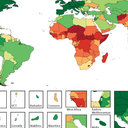Endemic necrotizing enterocolitis: lack of association with a specific infectious agent.
Märksõnad
Abstraktne
We conducted a comprehensive analysis of bacterial, parasitic and viral agents present in stool samples of 23 necrotizing enterocolitis cases and 23 matched and 10 random controls. Enterococcus spp., Staphylococcus epidermidis, and Escherichia coli were the most common aerobic bacterial species isolated. Astrovirus was identified in a stool sample from one control. Eight infants were bacteremic; in 7 of 8 the same organism was also present in the stool. No one bacterial species or strain (as identified by plasmid profile analysis) was associated with occurrence of illness. Plasmid analysis further suggested that each infant was colonized with his or her own distinctive aerobic bacterial flora. With the exception of isolates from two control patients which hybridized with a probe for diffuse adherence, no diarrheagenic E. coli was identified. Five (45%) of 11 case infants were colonized with coagulase-negative staphylococci (all S. epidermidis) that produced delta-hemolysin in vitro, as compared with 13 (87%) of 15 control infants. Necrotizing enterocolitis was not associated with an increased ability to ferment carbohydrate, as measured by in vitro beta-galactosidase activity. Our data do not support the hypothesis that endemic necrotizing enterocolitis in our institution is caused by a single infectious agent, nor was there evidence that previously proposed virulence mechanisms such as production of delta-hemolysin or increased in vitro carbohydrate fermentation play a critical role in disease occurrence.


